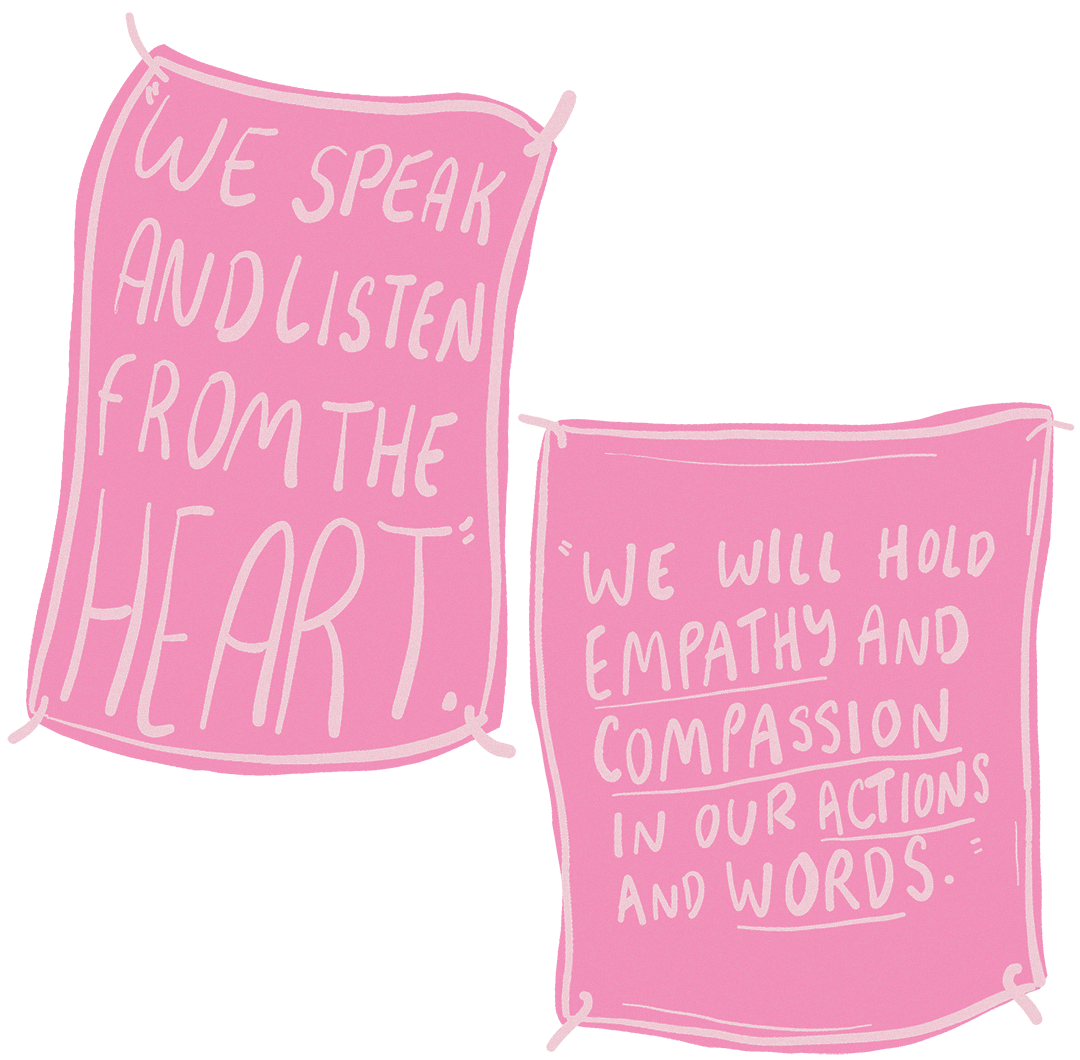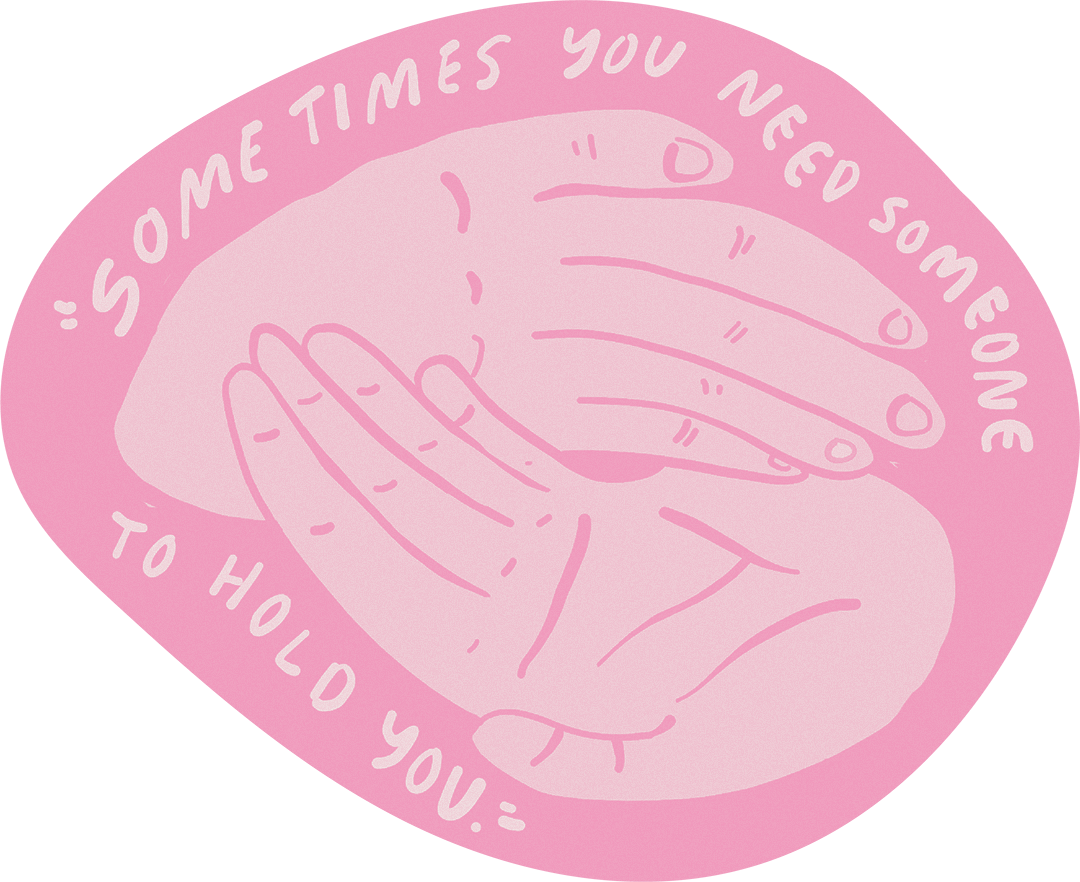ACCOUNTABILITY & INTENTION
What is the role of contracts or shared agreements in setting intentions, expectations, and priorities in the group, as well as holding folks accountable to them?
Always create contracts or shared agreements before entering the project, collective, or working relationship. Contracts or shared agreements can focus on the general themes of needs, expectations, and accountability, as well as anything else that seems significant to the group. These can be broken down in the following ways:
1
Needs: Needs can be understood from two (or more) perspectives; group members can consider what need their involvement in the group fulfills for them as individuals, as well as what their needs are from the group as members.
What are group members looking to get out of the work? What are everyone's different or overlapping needs for being thoughtful group members? What conditions are group members operating out of within their lives? It’s helpful to communicate these as clearly as possible at the beginning so that group members can have an understanding of the perspective and conditions each person is coming from and build a ground from which empathy can grow.
2
Expectations: Creating a set of shared expectations with the group is helpful in establishing accountability at a later point as well as understanding if there is alignment among group members.
What do group members expect of one another in the working relationship? What can and can’t group members commit to? How is credit, payment, and labor distributed among group members? What specific roles do group members want to play? What level of priority does the collective work take in each individual’s life? Is there a set of basic expectations that group members are required to meet in order to be part of the group? Group members may want to start with high expectations for one another and make time to adjust them together as the working relationships evolve. It may also be helpful to set boundaries for involvement: Some people have a tendency to get overly involved and take on too many tasks for the group. After establishing expectations for one another, group members can have a more expansive conversation around accountability processes and how the group can better support, care, or respond to group members who do not meet the basic expectations. If there is misalignment in the expectations, for example, if the priority or stake in the work varies for different group members, this could be addressed through different types of credit, payment, or roles that group members hold. Because misalignment in level of priority or stake in the work may become a point of tension within the working relationship, it is very helpful to address this at the beginning of the project, as well as through regular check-ins as the group evolves.
3
Accountability: Establishing an accountability process from the start is important so folks have a system for addressing issues as they arise. Being tender and understanding to your collaborators’ needs, conditions, and life experiences is essential to any meaningful accountability process. It’s equally important that each group member is rigorously honest and reflective on their own position and what they can genuinely take on within the project. Create regular check-ins outside of the group’s “work” specifically to reflect on the expectations the group sets for one another, how each person is doing in meeting those expectations, and if they need to be readjusted. If there is a discrepancy between what group members say they can take on and what they can actually take on, acknowledge it with care, using a decolonized nonviolent communication
method or other communication methods outlined in the
resources section. Collectives, like organisms, are born, they live, and they die. Sometimes the group work no longer serves you and it’s OK to step away.
How do you negate the negative associations with contracts?
Contracts are an organizational tool. They are agreements between people for setting boundaries for the work and ourselves. They can be used for accountability processes. It’s helpful to set intentions together with your collaborators and lay out your personal goals directly and clearly. If people feel uncomfortable sharing directly, find anonymous ways of sharing and having open dialogue. You can find ways to make contracts more fun and less serious. Take time to reflect and talk throughout every part of the contract process. Check in on one another throughout every part of the process, making sure the other person or people feel heard and accommodated. Make sure to include payment, credit, ownership, and rights to the materials as part of the contract.
COMMUNICATION &
CONFLICT
How can you facilitate and contribute to meaningful conversations within the group, especially when disagreements or interpersonal issues arise?
Interpersonal issues come about at various points in the work. It’s not always easy to anticipate what issues you may have with someone until you start working together. There are a few techniques for communicating through differences:
1
Use Yes, And. Instead of shutting down ideas you are not excited about, you can add your idea to the mix. It’s important to process information and brainstorm together. Ideas are also allowed to change throughout the discussion.
2
Use specific language, avoid using language that is dismissive or dominating. Think about how you are being present in the group.
3
Frame ideas as open-ended and actually be open to others’ perspectives and the potential for your own idea to not be a great fit.
4
Use neutral questions and have open communication when brainstorming and discussing. Taking inspiration from Liz Lerman’s Critical Response Process,
1
1
1
Lerman, Liz. “Critical Response Process: A Method for Giving and Getting Feedback.”
lizlerman.com/critical-response-process.
you can set specific time aside to ask permission to share opinions on in-process ideas. It’s helpful to be open to listening and to the potential to be wrong.
5
Practice reflective listening. Learn about the group and its members’ histories, and try to build on those histories with your perspective.
6
Stand up for what you believe in! Observe how group members respond. In a healthy group, even if folks disagree, they will try their best to understand your perspective and come to a healthy resolution.
7
Mention others’ ideas and try to build off of them within the conversation. Amplify others’ contributions, especially if their voices are new or have been historically repressed or misrepresented.
2
2
2
The practice of “amplification” is a conversation tool that has been used to center the voices of folks who are presently or have been historically suppressed. One example of its use is written about in the article, “White house women want to be in the room where it happens,” by
Juliet Eilperin published in the Washington Post, and can be read
here.
8
Always keep in mind that collaborating and working cooperatively is a survival skill, it’s not always a choice. There are some members of the group who have different levels of stake in the project, depending on their circumstances and personal experiences.
9
Try stepping back before stepping in when there is a conflict. Reflect on your own role and responsibility in the group.
10
Find ways of addressing toxic behavior directly with your group members by following the steps outlined in the next question, including: 1. Hold space for learning and growth, 2. Apply a restorative justice approach, 3. Ritual, reset and reconcile.
In addition to the techniques we suggested above, using a decolonized practice of nonviolent communication, as developed in the publication
Decolonizing Non-Violent Communication,
3
3
3
Meenadchi. Decolonizing Non-Violent Communication. Co-Conspirator Press , 2020.
by Meenadchi, may be an extremely helpful tool.

What do you do if you observe toxic behavior? How do you know when to call someone
out and when to call someone in?
If you observe toxic behavior such as, for example, that someone’s intentions in doing the work are more based on personal gain, when the collective’s intentions are based on social or political goals, you can call someone
in several ways before calling them out publicly.
1
Hold space for learning and growth: toxic behavior is embedded in us through the toxic culture we live in. It's helpful to approach toxicity from a place of curiosity rather than assumption. If someone is showing signs of toxic behavior that may come from a place of ignorance, hold space for learning and growth through a conversation that centers the unmet needs of group members, especially those who may have experienced harm, rather than blame.
2
Apply a restorative justice approach: Apply the learnings of restorative justice in instances when one group member does direct harm to another. By inviting an outside facilitator, or applying these practices on your own, hold space for group members to share the impact of each other's actions and come up with a specific plan for restoration.
4
4
4
The teachings of transformative justice may be applied on a small scale within the culture and labor practices of the collective. The organization GenerationFIVE offers helpful resources and advice that can be accessed at
generationfive .org/resources.
3
Reconcile, ritual, and reset: After the toxic behavior, conflict, or misunderstanding has been addressed, hold space for a group ritual, reset, or reconciliation process, so that the group is able to put the conflict at rest, while keeping in mind the learnings that emerged. This can take various forms, from a reflection on what group members are grateful for, a shared meditation, movement-based practice, or a shared meal.
Going through these steps and kindred processes can be a way of building solidarity around recognizing systemic and cultural problems. If you are fearful of losing your place in the group or placing yourself in a position of harm by bringing these issues up, think about peers or allies you can reach out to or who may reach out to you. You can use people’s proximity to power and privilege to call for change collectively. Use solidarity strategies from social justice work: “If you want to fire one of us, you’ll have to fire all of us.”
5
5
5
This is a quote from Bilphena Yahwon who talked about solidarity strategies within one of the workshops Press Press hosted to build the basis of this toolkit.
Find your allies or be an ally. Remember that calling someone out or in is not a one-time thing, it is a process.
Can you encourage the removal of people who may be toxic to the group or project?
No one person in the group should have the responsibility of deciding who stays and who leaves. If it comes to this, you can try several approaches: Bring an outside person in to facilitate a conversation and consult on the problem from a restorative or transformative justice perspective; create a new contract that outlines future needs, expectations, and an accountability process; bring in folks from other organizations to learn about how they navigate problems.
If one person needs to be removed, it should be the responsibility of the group together to make that decision. Sometimes there is no resolution. If the collaboration no longer serves you, it’s OK to leave. Accept the ephemeral nature of the work. Sometimes projects are no longer what you need them to be.
Sometimes it’s harder to hold close friends accountable than people you only have professional relationships with. How do you address this with care?
Having both professional and interpersonal relationships with your collaborators can be difficult. It is helpful to acknowledge both types of relationships that are at play. If one group member does not have the capacity or interest in the work, bring it up to them with care and respect. Explain your own stake in the work and why you are concerned. It’s not about blame. It’s about having clarity on your expectations of one another; what you can and cannot depend on the other to do. Clarity in all aspects of the work is necessary for accountability.
How do you navigate unwanted romantic advances with people you work with, especially if you don’t want to end the working relationship?
When you start to sense a romantic tension, try approaching it directly. Explain your intentions clearly and be as genuine and sensitive as you can be to the other person. If the issue continues and becomes a form of harassment, bring in your other group members or an outside facilitator to address the issue. The steps outlined in the earlier section on how to address perceived toxic behavior may also be altered and applied in these situations.
PERSONAL & COLLECTIVE GROWTH
How do you build a shared culture in the group?
Often, group members come from different backgrounds and hold different sets of experiences, knowledge, and sensitivities. Gathering and distributing various reading materials, articles, and books to introduce group members to new ideas are one way of getting group members on the same page. It’s important to collect a diverse set of materials that reflect the different perspectives of each group member.
It can be helpful to coordinate social justice trainings—such as political education workshops on the manifestations of racism, white supremacy, patriarchy, or homophobia within leftist or liberal spaces, restorative and transformative justice facilitation trainings, or facilitation from an anti-oppression lens—with all members of the group as a prerequisite for joining. All members should have at least a basic understanding of the structures that produce our different social positions and be equipped with a set of tools to help them navigate challenging situations with care and respect.
Building a shared culture in the group also comes from prioritizing your relationships as part of the work. Prioritizing relationships as part of the work can mean a multiplicity of things, including critically acknowledging the socioeconomic conditions that our relationships are based in; knowing what’s going on in collaborators’ lives; learning how to best support, care for, and anticipate one another’s needs; hearing life updates before delving into the “work” (if time allows); doing “non-work” activities together; and much more.
It would be great to assume that everyone involved in the collective work is doing their best to be engaged and accountable. However, it’s not always possible for all group members to hold the collective work at the same level of priority within their lives. This is an important factor to consider openly with group members and possibly even negotiate with a contract at the beginning of the working relationship. This consideration is addressed in the section
Accountability & Intention
where we delve into setting expectations, intentions, and contracts with group members.

How does the group treat the personal growth of its members?
Being a part of a cooperative project, organization, or collective means being committed to other group members’ personal growth and wellbeing. Personal growth and wellness is necessary for the overall health of the collective. If people aren’t learning and growing together the work will fall apart. Share resources with one another. Support and embrace one another by sharing of yourself in the ways that you can, both within and outside of your shared work. Understand that the nature of the work may change as members of the group also undergo changes.
How do you balance life and work in the group?
Be reflective about your life and what you can take on, and then be honest with those around you. If you can’t find a balance, maybe you’ve taken on too much. Prioritize your needs and then go from there. If you build a culture of open and consistent communication, group members will be more likely to understand your perspective and the circumstances that you operate within.
How do you invite sustained participation from new collaborators or group members?
People participate in group work in various ways and at various levels. In order to increase and sustain participation, try creating more and less involved ways people can contribute that include small and large time commitments and skill levels. People have different skills and ways of expression.
How can you be accommodating of those differences?
6
6
6
Drawing from Iris Marion Young’s notion of a politics of difference, outlined in the book Justice and the Politics of Difference, may be helpful here. As you build your collective, especially if it is inclusive of people of multiple backgrounds and life experiences, remember that people are positioned differently in social space, and have different needs, skills, and perspectives. How can you find ways of embracing and accommodating those differences within your shared working processes?
